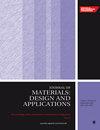商用和椰壳增强材料鼓式制动器衬片的制动尖叫有限元性能比较
IF 2.2
4区 材料科学
Q3 MATERIALS SCIENCE, MULTIDISCIPLINARY
Proceedings of the Institution of Mechanical Engineers, Part L: Journal of Materials: Design and Applications
Pub Date : 2024-04-18
DOI:10.1177/14644207241247741
引用次数: 0
摘要
制动器在汽车中起着至关重要的作用,它将动能转化为热能和振动。制动尖叫是一种令人不舒服的噪音现象,对鼓式和盘式制动器都进行过深入研究。许多研究都探讨了材料、温度和操作等因素如何影响制动器的不稳定性和噪音。然而,商用鼓式制动器衬片通常含有有害的石棉。这会带来健康风险,使人接触到空气中的有害微粒,尤其会影响肺部健康。因此,目前的研究旨在开发不含石棉的替代衬片,优先考虑降低磨损率,同时保持与传统衬片相当的效果。这些替代品主要使用有机材料进行加固。然而,很少有研究对这些基于生物材料的衬里与商用衬里的性能进行评估。本研究旨在通过分析重型车辆的后轴鼓式制动器,比较两种衬片来弥补这一差距:一种是市售衬片,另一种是用椰壳加固材料专门制作的衬片。ANSYS 软件为两种衬片设置了五个类似的模拟阶段。每个阶段包括瞬态热模拟和静态模拟。输入参数的选择是为了模拟真实的制动情况,由此产生的预应力状态被用于进行复杂的模态分析,从而提取出负责稳定性的特征值和数值。结果证明,椰子壳等生物材料可用于工业用途,如制造刹车片或刹车衬片,从而创造出一种更便宜、污染更少且不易产生刹车异响的材料。本文章由计算机程序翻译,如有差异,请以英文原文为准。
Brake squeal finite element performance comparison between commercial and coconut shell-reinforced material drum brake linings
Brakes play a vital role in vehicles, converting kinetic energy into heat and vibration. Brake squeal, an uncomfortable noise phenomenon, has been thoroughly researched in both drum and disc brakes. Many studies have explored how factors such as material, temperature, and operations impact brake instability and noise. Yet, commercial drum brake linings often contain hazardous asbestos. This poses health risks, exposing individuals to harmful airborne particles, particularly affecting lung health. Hence, current research aims to develop asbestos-free alternative linings, prioritizing reduced wear rates while maintaining effectiveness comparable to traditional ones. These alternatives primarily use organic materials for reinforcement. However, few studies have evaluated the performance of these biomaterial-based linings against commercial counterparts. This study aims to bridge this gap by analyzing a rear-axle drum brake from a heavy vehicle, comparing two linings: One commercially available and the other specially made with coconut shell reinforcement, in a finite element software. Five similar simulation stages were set for both linings in the ANSYS software. Each stage comprises transient thermal and static simulations. The input parameters were chosen to simulate a real braking situation, and the resulting pre-stress state was used to conduct complex modal analysis, which extracted the eigenvalues and values responsible for stability. The results proved that biomaterials such as coconut shells can be used for industrial purposes, such as the manufacture of a brake pad or lining, creating a cheaper, less polluting, and less brake squeal-inducing material.
求助全文
通过发布文献求助,成功后即可免费获取论文全文。
去求助
来源期刊

CiteScore
4.70
自引率
8.30%
发文量
166
审稿时长
3 months
期刊介绍:
The Journal of Materials: Design and Applications covers the usage and design of materials for application in an engineering context. The materials covered include metals, ceramics, and composites, as well as engineering polymers.
"The Journal of Materials Design and Applications is dedicated to publishing papers of the highest quality, in a timely fashion, covering a variety of important areas in materials technology. The Journal''s publishers have a wealth of publishing expertise and ensure that authors are given exemplary service. Every attention is given to publishing the papers as quickly as possible. The Journal has an excellent international reputation, with a corresponding international Editorial Board from a large number of different materials areas and disciplines advising the Editor." Professor Bill Banks - University of Strathclyde, UK
This journal is a member of the Committee on Publication Ethics (COPE).
 求助内容:
求助内容: 应助结果提醒方式:
应助结果提醒方式:


